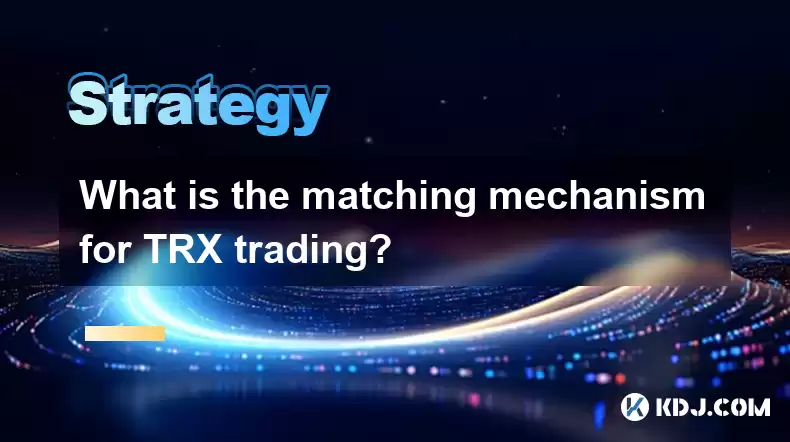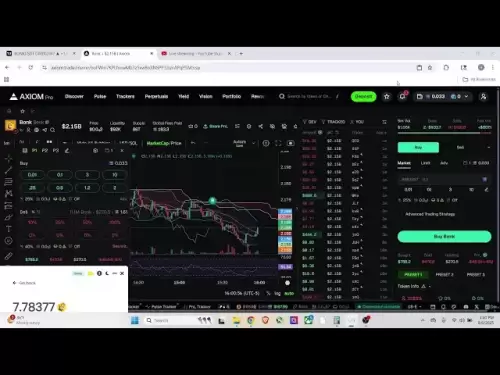-
 Bitcoin
Bitcoin $116200
1.84% -
 Ethereum
Ethereum $3841
6.86% -
 XRP
XRP $3.070
4.25% -
 Tether USDt
Tether USDt $1.000
0.02% -
 BNB
BNB $774.4
1.72% -
 Solana
Solana $172.3
5.17% -
 USDC
USDC $0.9999
0.01% -
 Dogecoin
Dogecoin $0.2136
6.85% -
 TRON
TRON $0.3391
1.21% -
 Cardano
Cardano $0.7667
5.76% -
 Hyperliquid
Hyperliquid $39.10
4.30% -
 Sui
Sui $3.724
9.37% -
 Stellar
Stellar $0.4139
5.86% -
 Chainlink
Chainlink $17.35
6.09% -
 Bitcoin Cash
Bitcoin Cash $573.7
2.52% -
 Hedera
Hedera $0.2518
5.39% -
 Ethena USDe
Ethena USDe $1.001
0.02% -
 Avalanche
Avalanche $22.68
3.57% -
 Litecoin
Litecoin $120.4
3.89% -
 UNUS SED LEO
UNUS SED LEO $8.951
-0.40% -
 Toncoin
Toncoin $3.312
4.62% -
 Shiba Inu
Shiba Inu $0.00001263
4.23% -
 Uniswap
Uniswap $10.14
6.89% -
 Polkadot
Polkadot $3.778
5.04% -
 Dai
Dai $1.000
0.01% -
 Monero
Monero $276.9
-4.52% -
 Bitget Token
Bitget Token $4.394
1.57% -
 Cronos
Cronos $0.1475
6.05% -
 Pepe
Pepe $0.00001081
5.27% -
 Aave
Aave $274.5
7.59%
What is the matching mechanism for TRX trading?
The TRX trading matching mechanism ensures fair and efficient trade execution by matching buy and sell orders, maximizing liquidity, and minimizing slippage.
Apr 20, 2025 at 12:07 pm

The matching mechanism for TRX trading is a critical aspect of the TRON ecosystem, ensuring that trades are executed fairly and efficiently. This mechanism is designed to match buy and sell orders in a way that maximizes liquidity and minimizes slippage. Understanding how this works can help traders make more informed decisions and optimize their trading strategies.
The Basics of TRX Trading
TRX, or Tronix, is the native cryptocurrency of the TRON blockchain. It is used for various purposes within the ecosystem, including transaction fees and staking. When trading TRX, users engage in the buying and selling of this token on various cryptocurrency exchanges. The matching mechanism is the process by which these buy and sell orders are matched and executed.
Order Types in TRX Trading
In TRX trading, there are several types of orders that traders can place. Understanding these order types is essential for grasping the matching mechanism.
Market Orders: These are orders to buy or sell TRX at the current market price. They are executed immediately at the best available price, which can be advantageous for quick trades but may result in higher slippage.
Limit Orders: These allow traders to set a specific price at which they want to buy or sell TRX. The order will only be executed if the market reaches the specified price. Limit orders provide more control over the execution price but may not be filled if the market does not reach the desired price.
Stop Orders: These are used to limit losses or protect profits. A stop order becomes a market order once the TRX price reaches a specified stop price. They are useful for managing risk but can also result in slippage.
The Matching Engine
The heart of the matching mechanism for TRX trading is the matching engine. This is a sophisticated software system that processes and matches buy and sell orders according to predefined rules. The primary goal of the matching engine is to ensure that trades are executed in a fair and efficient manner.
Order Book: The matching engine uses an order book, which is a list of all outstanding buy and sell orders. The order book is organized by price level, with the highest bid (buy order) and the lowest ask (sell order) at the top.
Price-Time Priority: The matching engine typically follows a price-time priority rule. This means that orders at better prices are executed first, and among orders at the same price, those placed earlier are prioritized.
Partial Fills: In some cases, a large order may be matched against multiple smaller orders. This is known as a partial fill, where the large order is executed in parts until it is fully filled or until there are no more matching orders.
The Role of Liquidity in TRX Trading
Liquidity is a crucial factor in the matching mechanism for TRX trading. High liquidity means there are many buy and sell orders at various price levels, allowing for faster and more efficient trade execution. Low liquidity can lead to larger spreads between the bid and ask prices, resulting in higher slippage and less favorable execution prices.
Market Makers: These are participants who provide liquidity by placing both buy and sell orders. They profit from the spread between the bid and ask prices and help ensure that there are always orders available for matching.
Liquidity Pools: Some decentralized exchanges use liquidity pools, where users can deposit TRX and other tokens to provide liquidity. These pools are used to match trades, ensuring that there is always a counterparty for a trade.
Slippage and Its Impact on TRX Trading
Slippage is the difference between the expected price of a trade and the actual price at which the trade is executed. It is a common occurrence in TRX trading, especially during periods of high volatility or low liquidity.
Factors Affecting Slippage: Several factors can influence slippage, including the size of the order, the current market conditions, and the liquidity of the TRX market. Larger orders are more likely to experience slippage because they may exhaust the available liquidity at the best price levels.
Minimizing Slippage: Traders can take several steps to minimize slippage, such as using limit orders instead of market orders, trading during periods of high liquidity, and breaking up large orders into smaller ones.
The Importance of Fairness in TRX Trading
Fairness is a key principle in the matching mechanism for TRX trading. The system must ensure that all participants have an equal opportunity to have their orders matched and executed. This is achieved through transparent rules and the use of technology to prevent any form of manipulation.
Transparency: The matching mechanism should be transparent, with clear rules and real-time visibility of the order book. This allows traders to see the current market conditions and make informed decisions.
Anti-Manipulation Measures: Exchanges implement various measures to prevent market manipulation, such as monitoring for suspicious trading patterns and enforcing strict rules on order placement and cancellation.
Frequently Asked Questions
Q: How does the matching mechanism handle large orders in TRX trading?
A: Large orders in TRX trading are handled through partial fills, where the order is matched against multiple smaller orders until it is fully executed. This process helps to minimize the impact of large orders on the market and ensures that they are filled as efficiently as possible.
Q: Can the matching mechanism be manipulated in TRX trading?
A: While the matching mechanism is designed to be fair and transparent, there is always a risk of manipulation. Exchanges implement various anti-manipulation measures to detect and prevent such activities, but traders should remain vigilant and report any suspicious behavior.
Q: What role do decentralized exchanges play in the matching mechanism for TRX trading?
A: Decentralized exchanges (DEXs) use smart contracts and liquidity pools to match trades. These systems are designed to be transparent and resistant to manipulation, providing an alternative to centralized exchanges for TRX trading.
Q: How does the matching mechanism affect the price of TRX?
A: The matching mechanism can influence the price of TRX by determining how buy and sell orders are executed. High liquidity and efficient matching can lead to more stable prices, while low liquidity and large orders can cause price volatility.
Disclaimer:info@kdj.com
The information provided is not trading advice. kdj.com does not assume any responsibility for any investments made based on the information provided in this article. Cryptocurrencies are highly volatile and it is highly recommended that you invest with caution after thorough research!
If you believe that the content used on this website infringes your copyright, please contact us immediately (info@kdj.com) and we will delete it promptly.
- Ollama Turbo & GPT-OSS: Revolutionizing AI Model Accessibility and Speed
- 2025-08-07 20:29:33
- Bitcoin Ordinals: NFTs Evolving Bitcoin or a Fleeting Fad?
- 2025-08-07 20:29:33
- BlockchainFX, Bitcoin Swift, Crypto Presales: What's the Hype?
- 2025-08-07 19:10:13
- Pepe Dollar (PEPD) vs. SPX6900: The Meme Coin Battle of 2025
- 2025-08-07 19:50:12
- XRP Investment Regret: Are You Missing Out on the Next Big Thing?
- 2025-08-07 19:50:12
- XRPINU: More Than Just a Meme? Roadmap, Liquidity, and the Future of Funny Money
- 2025-08-07 19:56:46
Related knowledge

How to avoid common crypto investment mistakes?
Jul 13,2025 at 01:35am
Understanding the Risks of Crypto InvestmentInvesting in cryptocurrency can be highly rewarding, but it also comes with significant risks. One of the ...

What is a long-short crypto strategy?
Jul 15,2025 at 10:56am
Understanding the Basics of a Long-Short Crypto StrategyA long-short crypto strategy is an investment approach where traders simultaneously take long ...

What is a long-short crypto strategy?
Jul 11,2025 at 01:28pm
Understanding the Basics of Long-Short Crypto StrategyA long-short crypto strategy is an investment approach where traders take both long and short po...

How to use the RSI indicator for crypto?
Jul 12,2025 at 03:56pm
Understanding the RSI Indicator in Cryptocurrency TradingThe Relative Strength Index (RSI) is a momentum oscillator used to measure the speed and chan...

Is copy trading a good strategy for crypto beginners?
Jul 12,2025 at 08:28am
Understanding Copy Trading in the Cryptocurrency MarketCopy trading is a strategy where novice traders replicate the trades of experienced investors a...

How to build a crypto portfolio with $1000?
Jul 13,2025 at 08:14pm
Understanding the Basics of Cryptocurrency InvestmentBuilding a crypto portfolio with $1000 starts with understanding the fundamentals of cryptocurren...

How to avoid common crypto investment mistakes?
Jul 13,2025 at 01:35am
Understanding the Risks of Crypto InvestmentInvesting in cryptocurrency can be highly rewarding, but it also comes with significant risks. One of the ...

What is a long-short crypto strategy?
Jul 15,2025 at 10:56am
Understanding the Basics of a Long-Short Crypto StrategyA long-short crypto strategy is an investment approach where traders simultaneously take long ...

What is a long-short crypto strategy?
Jul 11,2025 at 01:28pm
Understanding the Basics of Long-Short Crypto StrategyA long-short crypto strategy is an investment approach where traders take both long and short po...

How to use the RSI indicator for crypto?
Jul 12,2025 at 03:56pm
Understanding the RSI Indicator in Cryptocurrency TradingThe Relative Strength Index (RSI) is a momentum oscillator used to measure the speed and chan...

Is copy trading a good strategy for crypto beginners?
Jul 12,2025 at 08:28am
Understanding Copy Trading in the Cryptocurrency MarketCopy trading is a strategy where novice traders replicate the trades of experienced investors a...

How to build a crypto portfolio with $1000?
Jul 13,2025 at 08:14pm
Understanding the Basics of Cryptocurrency InvestmentBuilding a crypto portfolio with $1000 starts with understanding the fundamentals of cryptocurren...
See all articles

























































































